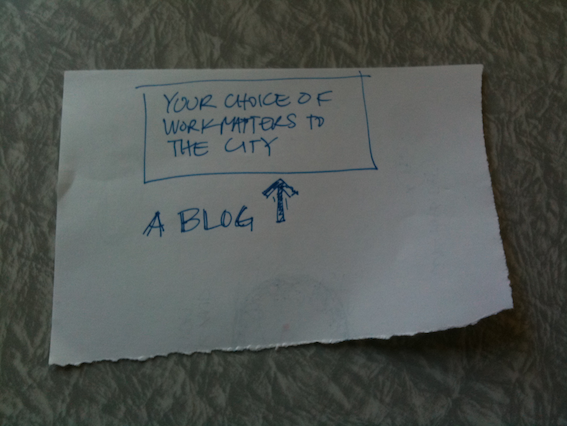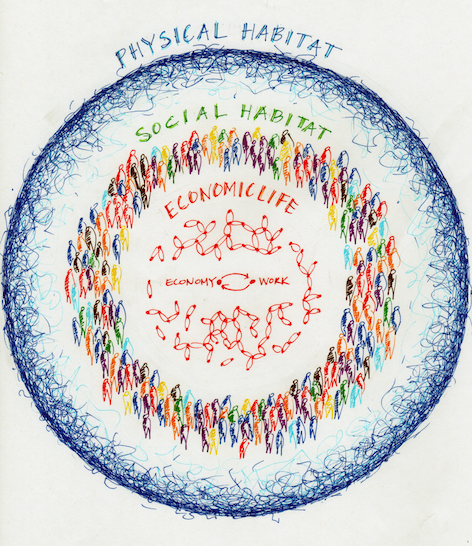Cities are not all that straightforward. They are hard to figure out and make sense of. They are tricky and messy. They can make us quite uneasy, yet they are clearly where most of us choose to live. Living in cities is a choice. It is a journey we have chosen, even though it makes us uneasy from time to time. It is an uneasy journey
The next series of posts focus on the left circle of the Nest Works, shown above. We will take a look at the things that make us itchy and uneasy and discern some practical principles and practices that will support us in our city life. These principles and practices will support us in our efforts to create cities that serve citizens well. Perhaps most importantly, we can learn how to be citizens that serve cities well.
To begin, I revisit a 2009 post called The runaway train, the dinosaur and the house of cards, that emerged from reading Ronald Wright’s A Short History of Progress. Here are two passages to note from Wright:
The myth of progress has sometimes served us well – those of us seated at the best tables, anyway – and may continue to do so. But I shall argue … that it has also become dangerous. Progress has an internal logic that can lead beyond reason to catastrophe. A seductive trail of successes may end up in a trap (p. 5). _____ _____ Civilization is an experiment, a very recent way of life in the human career, and it has a habit of walking into what I am calling progress traps. A small village on good land beside a river is a good idea; but when the village grows into a city and paves over the good land, it becomes a bad idea. While prevention might have been easy, a cure may be impossible; a city isn’t easily moved. This human inability to foresee – or to watch out for – long-range consequence may be inherent to our kind, shaped by the millions of years when we lived from hand to mouth by hunting and gathering. It may also be little more than a mix of inertia, greed and foolishness encour-(p 108)aged by the shape of the social pyramid. The concentration of power at the top of large-scale societies gives the elite a vested interest in the status quo; they continue to prosper in the darkening times long after the environment and general populace begin to suffer.Yet despite the wreckage of past civilizations littering the earth, the overall experiment of civilization has continued to spread and grow. The numbers (insofar as they can be estimated) break down as follows: a world population of about 200 million at Rome’s height, in the second century A.D.; about 400 million by 1500, when Europe reached the Americas; one billion people by 1825, at the start of the Coal Age; 2 billion by 1925, when the Oil Age gets underway; and 6 billion by the year 2000. Even more startling than the growth is the acceleration. Adding 200 million people after Rome took thirteen centuries. Adding the last 200 million took only three years (p. 108-109).Wright highlights Joseph Tainter‘s nicknames for three kinds of trouble that lead to the collapse of a civilization: the Runaway Train, the Dinosaur, and the House of Cards. An illustration of these phenomena are in Dickens’ Little Dorrit, a wonderful story of city life. You’ll see direct connection to today’s world.
Dickens illustrates the Runaway Train in Merdle’s Bank, where debt pays debt, and that debt pays more debt. Merdle alone, as the conductor of the train, sees the inevitable crash. He despises the Dinosaurs that seek his favour to “invest” with him, yet takes them on as passengers. The Dinosaurs continue to believe in his wisdom and prowess. ‘Society’ has complete faith in Society, hence Merdle. For Society, the financial returns will continue. This is what is owed to position, prestige and privilege. Status is taken for granted. There is nothing that can go wrong. But it does.
The House of Cards is found in the degradation and literal collapse of the Clenham household, and the rise and fall (and rise and fall again) of the Dorrit family. The Merdles themselves who have enjoyed privilege find it gone. The newfound wealth of the Dorrit family is gone. “I might go back to dancing,” says Fanny Dorrit. Her brother, Tip: “But what about me?” All in which they found meaning is gone.
Enter Arthur Clennam, in debtors’ prison as a result of inability to pay his creditors after having lost his fortune on Merdle’s Runaway Train. His despair is not from having lost his fortune, but from having let others down. His happiness in the end is as it always was – enjoying, and in relationship with, people regardless of their status and position in Society. Through Arthur Clennam and Amy Dorrit and the cast of characters that support them on their journey, we see that relationships are what endure in the world. If you count only on riches and material goods, then you can’t have much to count on. The House will eventually crumble.
In today’s world, Merdle’s Runaway Train is the fall of Wall Street. Dinosaurs refused to see – or let others see – that the economic train was heading fast down a path of disaster. The harm for many is substantial. The House of Cards is revealed. What we have can disappear in an instant.
In the news these last few weeks is the story of E. coli and 1500 meat products recalled across Canada and 30 states in the US. The highest ranked comment on the Canadian Broadcasting Corporation’s website declares this event a result of allowing corporations to self-regulate, similar to the US allowing Wall Street to self regulate. This looks like a Runaway Train.
It appears, if we stop and think about it, that our very existence is a House of Cards. Our privilege in the West is a House of Cards, and perhaps a Runaway Train. Whether it is the economic conditions of our time, or the environmental and health stresses at this time, let us be wary of the Dinosaur. It is what keeps us from noticing the Runaway Train and the House of Cards.
Then what is the opposite of Dinosaur? Awake, conscious, in tune with the world. In relationship with the world. In relationship with others in the world to seek understanding and solutions. A sense of happiness. In Little Dorrit, the happy folk have relationships that cross (yet keep) many boundaries – jailed and jailor, poor and rich, female and male, servant and master, harassed and harrassor, young and old, unloved and loved. Perhaps this is the antidote to the Dinosaur. A way of being that gets the best out of people for the challenges ahead.
It can’t really be named, this anti-Dinosaur, but it seems this is what will cultivate our needed collective ingenuity, for it is the Dinosaur that allows time to gather its moments secretly.
_____ _____ _____
This post forms part of Chapter 4 – An Uneasy Journey, of Nest City: The Human Drive to Thrive in Cities.
Nest City is organized into three parts, each with a collection of chapters. Click here for an overview of the three parts of Nest City. Click here for an overview of Part 2 – Organizing for Emergence, chapters 4-7.

